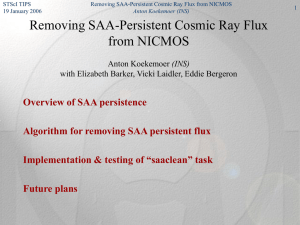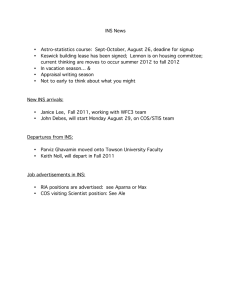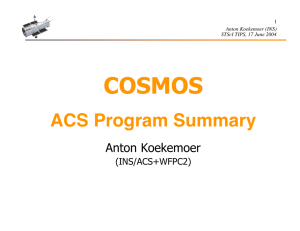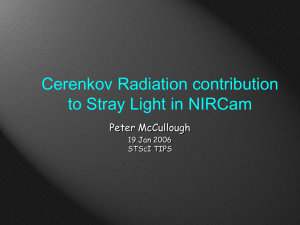TIPS-JIM Meeting 19 January 2006, 10am, Auditorium
advertisement
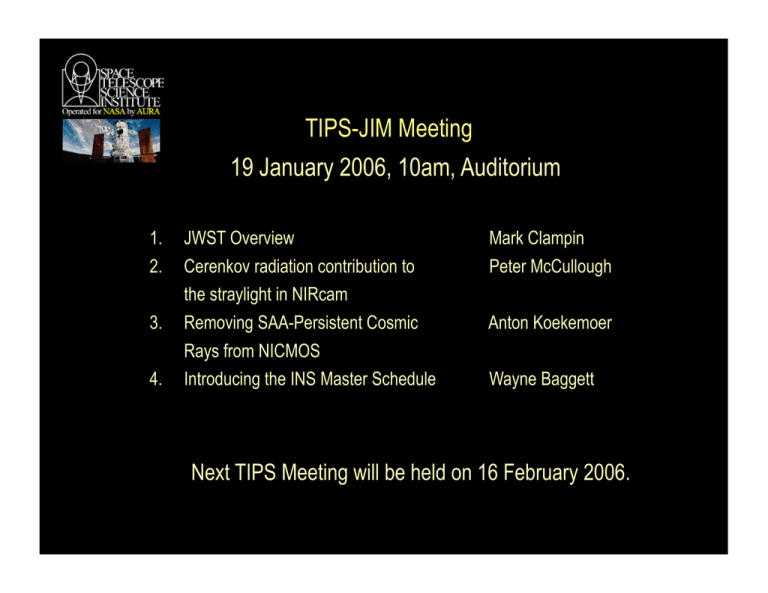
TIPS-JIM Meeting 19 January 2006, 10am, Auditorium 1. JWST Overview Mark Clampin 2. Peter McCullough 3. Cerenkov radiation contribution to the straylight in NIRcam Removing SAA-Persistent Cosmic Anton Koekemoer 4. Rays from NICMOS Introducing the INS Master Schedule Wayne Baggett Next TIPS Meeting will be held on 16 February 2006. JWST Overview Presentation is not currently available on-line TIPS-JIM Meeting 19 January 2006, 10am, Auditorium 1. JWST Overview Mark Clampin 2. Peter McCullough 3. Cerenkov radiation contribution to the straylight in NIRcam Removing SAA-Persistent Cosmic Anton Koekemoer 4. Rays from NICMOS Introducing the INS Master Schedule Wayne Baggett Next TIPS Meeting will be held on 16 February 2006. Cerenkov Radiation contribution to Stray Light in NIRCam Peter McCullough 19 Jan 2006 STScI TIPS History Cerenkov radiation was discovered by 30-year old Pavel Cerenkov in 1934 in the USSR. Cerenkov observed the emission of blue light from a bottle of water subjected to gamma rays*. His parents, Aleksei and Mariya Cerenkov, were peasants. He received the Nobel prize in 1958. He died in 1990. *Gamma rays accelerate electrons via the Compton effect. The relativistic electrons then create the Cerenkov effect. nobelprize.org and Google image search Some experiences with Cerenkov light Fly’s eye (George Rieke): detected Cerenkov light in atmosphere NIRCam pre-Phase A: Cerenkov glow from lenses not a problem HST FOS: stray light HST STIS near-UV channel: stray light HST STIS opto-isolators: miscommunication NIRCam Shortwave Imaging Path Physics The number of photons per nm of wavelength per cm of pathlength of the relativistic particle is 0.46E6 Z2 λ−2 (1-(β n)-2) Z=1 for the most common cosmic rays (protons) λ is the wavelength in nm, β = v/c, n=1.5 for the glasses within NIRCam. The coefficient 0.46E6 equals 2 π α times 1E7, the number of nm per cm, with the fine structure constant α = 1/137. The quantity (1-(β n)-2) ~ 0.5 for v = 0.9c and n=1.5. nobelprize.org Cone of light Physics applied: The integrated Cerenkov photon flux within a bandpass filter is proportional to λ−1 for a filter of a given resolution, such as R=4. The integral of all Cerenkov photons longer than a given λ (here in microns) is approximately equal to 230/λ photons per proton per cm of pathlength. To be both simple and conservative, we assume that every cosmic ray induces Cerenkov radiation, and the flux equals 5 protons/cm2/s inside NIRCam’s optics located in L2 orbit (cf. 0.25 protons/cm2/s at HST’s orbit outside SAA). Including Helium cosmic rays will increase Cerenkov luminosities by no more than a factor of 2. NIRCam Imaging Triplet Imaging triplet: NIRCam’s imaging triplet glows at λ > 0.5 microns with a luminosity of L = π/4 * (7 cm)2 * 4 cm * 5 ions/cm2/s * 460 photons/ion/cm L = 350,000 photons per second. If they escape isotropically, then the flux at the detector is 400 photons/s/SCA area, or ~1% of the maximum dark current or ~1% of the zodiacal light thru an R=100 filter. NIRCam FPA Fold Mirror Luminosity may not be isotropic: In a special case of a long bar or cylinder, nearly all of the Cerenkov radiation can be made to escape its ends due to either mirror coating or total internal reflection. The latter principle is exploited by Mack (2002) as shown below: Cosmic Ray path Glass Cerenkov photons Detectors Final Fold mirror: NIRCam’s SW final fold mirror, if it were not light-weighted, would glow at λ > 0.5 microns with a luminosity of L = (10 cm)2 * 2 cm * 5 ions/cm2/s * 460 photons/ion/cm L = 460,000 photons per second, which is comparable to the zodiacal light collected by one SCA through a F200W (R=4) filter. However the mirror is light-weighted and it appears to be contained within its mount such that glow from its back or sides cannot reach the detectors. Other luminescence not addressed here! “Hence we were inclined to think that this light produced by the gamma rays was one of the many luminescence phenomena. Pierre and Marie Curie thought so and they were incontestably among the first to observe this kind of light, at any rate under conditions where it was fairly heavily masked by the ordinary luminescence.” (Cerenkov’s Nobel lecture; P.R.M.’s emphasis) Summary The contribution to stray light in NIRCam due to Cerenkov radiation is … negligible from lenses. (in principle) significant from the final fold mirrors’ substrates but (in practice) can be blocked. Caveat: this author cannot adequately judge the effectiveness of that blocking from drawings available to him. Therefore: designers should be made aware of the need to contain the Cerenkov glow emitted by transparent materials within NIRCam and other instruments on JWST. See McCullough’s Technical Report, JWST-STScI-000558, and/or the following: TIPS-JIM Meeting 19 January 2006, 10am, Auditorium 1. JWST Overview Mark Clampin 2. Peter McCullough 3. Cerenkov radiation contribution to the straylight in NIRcam Removing SAA-Persistent Cosmic Anton Koekemoer 4. Rays from NICMOS Introducing the INS Master Schedule Wayne Baggett Next TIPS Meeting will be held on 16 February 2006. STScI TIPS 19 January 2006 Removing SAA-Persistent Cosmic Ray Flux from NICMOS Anton Koekemoer (INS) Removing SAA-Persistent Cosmic Ray Flux from NICMOS Anton Koekemoer (INS) with Elizabeth Barker, Vicki Laidler, Eddie Bergeron Overview of SAA persistence Algorithm for removing SAA persistent flux Implementation & testing of “saaclean” task Future plans 20 STScI TIPS 19 January 2006 Removing SAA-Persistent Cosmic Ray Flux from NICMOS Anton Koekemoer (INS) 21 SAA Persistence Overview of Persistence: NICMOS HgCdTe/CdTe bulk material contains small flaws that trap electrons produced by detected photons The trapped electrons are not read out together with all the other electrons detected in a given pixel Thermal excitation causes (Bergeron & Dickinson, NICMOS-ISR-2003-10) traps to release the electrons on longer timescales with a logarithmic decay Resulting flux appears in subsequent exposures, with a distribution that depends on the original intensity and the population of traps STScI TIPS 19 January 2006 Removing SAA-Persistent Cosmic Ray Flux from NICMOS Anton Koekemoer (INS) 22 South Atlantic Anomaly (SAA): Region in Earth’s magnetosphere where Van Allen belts dip closest to the surface, resulting from misalignment in Earth’s magnetic axis HST passes through it ~50% of the time, 8-9 orbits/day Although NICMOS is powered off, cosmic ray electrons are still trapped Cosmic ray rate is so high that persistence can increase total noise by 4-5x in subsequent exposures obtained long after the SAA passage (O. Lupie, WFC3-ISR-2002-01) (Bergeron & Dickinson, NICMOS-ISR-2003-10) STScI TIPS 19 January 2006 Removing SAA-Persistent Cosmic Ray Flux from NICMOS Anton Koekemoer (INS) 23 Removing SAA Persistent Flux Post-SAA darks: After each SAA passage when NICMOS transitions from SAAOPER to OPERATE, a pair of dark exposures is obtained: – ACCUM mode, NREAD=25, EXPTIME=256s – Darks start 174s and 444s after exiting the SAA Calibrate the darks to remove other instrumental signatures (pedestal etc) Create average post-SAA dark image: – scale the 2nd dark to the level of the 1st dark, using the decay time constant – average the 2 darks to remove CRs accumulated during the dark exposures (Bergeron & Dickinson, NICMOS-ISR-2003-10) STScI TIPS 19 January 2006 Removing SAA-Persistent Cosmic Ray Flux from NICMOS Anton Koekemoer (INS) 24 Subtracting the SAA model: The average of the 2 post-SAA darks is the SAA model, representing all the CRs accumulated during SAA passage Scale and subtract from the calibrated (pedestal-corrected) science image Scale factor is determined iteratively: – – – – multiply SAA model image by small scale factors subtract from science image measure the resulting noise (FWHM of Gaussian fit to pixel histogram) Plot noise as a function of scale factor, fit parabola to determine optimal scale STScI TIPS 19 January 2006 Removing SAA-Persistent Cosmic Ray Flux from NICMOS Anton Koekemoer (INS) 25 Fitting for High and Low pixels: Some CRs during SAA have higher energy and/or occur later than others Need to fit different scale factors, depending on the level of the residual signal In practice, divide the pixel histogram into 2 regimes: low and high Determine separate scale factors, and only apply a correction if the reduction in noise is > 1% STScI TIPS 19 January 2006 Removing SAA-Persistent Cosmic Ray Flux from NICMOS (Barker & Koekemoer, 2005 HSTAnton Cal Workshop Koekemoer (INS) 26 Example Results Before SAAclean Post-SAA Dark After SAAclean SAA CR Persistence model STScI TIPS 19 January 2006 Removing SAA-Persistent Cosmic Ray Flux from NICMOS Anton Koekemoer (INS) 27 Implementation of SAAclean task Original script: IDL, provided by E.Bergeron New version: Python code, written by Vicki Laidler, following original IDL prototype Installed as Pyraf/STSDAS hst_calib.nicmos.saaclean Some slight differences in algorithms (mostly related to IDL fitting functions that are unavailable or different in Pyraf) Inputs: – calibrated exposure (optionally corrected for pedestal effect) – Post-SAA darks (read from the image header) Output: – – – – calibrated exposure with the SAA model subtracted SAA model (in off-line version) Lots of output text containing information about the fitting process Fitting parameters also stored in header keywords STScI TIPS 19 January 2006 Removing SAA-Persistent Cosmic Ray Flux from NICMOS Anton Koekemoer (INS) 28 Testing Procedures Compare IDL and Pyraf versions: run on the full variety of datasets, ranging from extreme SAA events to datasets that are not impacted resulting model files and output images compared, examining: – noise in the images – individual pixels – dependence on quality of bad pixel files Results: – some differences between IDL and Pyraf; generally only in treatment of bad pixels, while SAA-impacted pixels showed the same behaviour Full test of the Pyraf version: Ran on all SAA-impacted NIC1,2,3 exposures ever obtained (>6,000) Examined images, as well as the output values of: – – – – chi-sq nhigh/nlow pixels and the threshold value scale correction factor noise reduction values STScI TIPS 19 January 2006 Removing SAA-Persistent Cosmic Ray Flux from NICMOS Anton Koekemoer (INS) 29 Future Plans Off-line version: Prototype version was released publicly in STSDAS 3.4 (Nov 1, 2005) Available for use within STScI and in the outside community; feedback solicited Finalize addressing minor issues turned up in very extreme datasets (very low or very high chi-sq, or low/high pixel regimes not well modelled): – appears that all of these can be fixed by using the correct bad pixel files Add some additional parameters to improve flexibility of iterations Next release likely in Feb/Mar 2006 Pipeline version: Aim to incorporate all improvements in off-line version by Feb/Mar 2006 Likely release to OPUS in Apr/May 2006 Initially only run on data that is within 1 orbit of SAA passage Correction only applied if noise reduction is >1% Continue to solicit feedback from community TIPS-JIM Meeting 19 January 2006, 10am, Auditorium 1. JWST Overview Mark Clampin 2. Peter McCullough 3. Cerenkov radiation contribution to the straylight in NIRcam Removing SAA-Persistent Cosmic Anton Koekemoer 4. Rays from NICMOS Introducing the INS Master Schedule Wayne Baggett Next TIPS Meeting will be held on 16 February 2006. Introducing the INS Master Schedule Wayne Baggett What Is It? • The INS Master Schedule – Captures “project-level” work led by INS – Includes work by other divisions – Captures HST observing-cycle activities • Does not capture every task being done within INS – Routine SI calibrations – Help Desk support What Will It Be Used For? • The INS Master Schedule will be used for – Tracking progress of the work – Identifying schedule conflicts – Identifying resource issues – Assessing resource allocations – Assessing impact of new work requests How Was It Produced? • INS SI Teams and other groups identified work items • Work Item Data Sheets written for each item – Describes work – Identifies INS Lead – Provides priority – Identifies deliverables How Was It Produced? HST INS Work Item Data Sheet 1. SI/Title: ACS/ASCS Study 2. INS Lead: M. Sirianni 3. Description of Work: Study temperature-dependencies of CTE, QE, dark current, bad pixel behavior to see if the ASCS is needed for the best operation of the ACS. Write one or more ISRs as the formal report of the study. Calibration data to support this study will be obtained in November 2005. 4. Schedule Constraints and Dependencies: An ASCS decision is needed from the HST Project by early Spring 2006. 5. Risks and Open Issues: Risk – If the calibration observations do not correctly complete in November 2005, then the study will be delayed. Mitigation: repeat any failed observations in the Spring. 6. Priority: High 7. Priority Justification: This study could have an impact on the SM4 manifest. 8. Resources (including estimated calendar duration for each portion): a. Requirements ACS Instrument Scientist (0.21 FTE) b. Development ACS Commanding Developer c. Testing ACS Commanding Developer Instrument Engineer 9. Documentation and Deliverables: Calibration ISR How Was It Produced? • Discussed work items with INS Division Office • Assigned work items to general time periods • Drafted the detailed near-term schedule • Work(ing) with other divisions to finalize this schedule – “If you’re part of the plan, you’re part of the planning.” Current Status • Draft Schedule exists and is starting to be used for tracking work progress – ACS! – STIS" – COS" – Cal Planning" – NICMOS – User Support • INS Master Schedule will be a “living” document – Updated regularly to reflect progress – Updated as needed to capture changes to existing work – Updated as needed to capture new work Current Status • Some Work Items still need to be defined • Schedule is still in draft form – Some items are missing – Discussion with other divisions needs to be completed Sample of Schedule Where to Find It • Web Site – http://www.stsci.edu/instruments/ins_mstr_sched/index.html – Contains • Link to INS Master Schedule (PDF) • Instrument and other group pages with Work Item Data Sheets – Maintained by W. Baggett TIPS-JIM Meeting 19 January 2006, 10am, Auditorium 1. JWST Overview Mark Clampin 2. Peter McCullough 3. Cerenkov radiation contribution to the straylight in NIRcam Removing SAA-Persistent Cosmic Anton Koekemoer 4. Rays from NICMOS Introducing the INS Master Schedule Wayne Baggett Next TIPS Meeting will be held on 16 February 2006.
